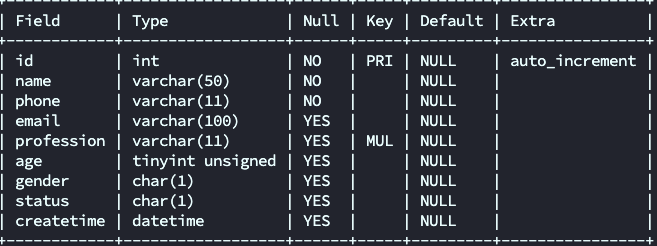MySQL 原理与优化,Group By 优化 技巧

今天来看看 MySQL 中如何多 Group By 语句进行优化的。
先创建 tb_user 表如下

通过 show index from tb_user; 命令查看表,没有存在任何的索引。

执行如下代码,查看 SQL 执行情况
explain select profession, count(*) from tb_user group by profession ;

发现返回结果中 type 为“ALL” ,Extra 返回“Using temporary” 说明没有使用索引。
于是,创建基于 profession,age 和 status 的索引如下
create index index_user_pro_age_sta on tb_user(profession ,age, status);
这里创建索引从左到右的顺序是 profession ,age, status。
此时再次执行 SQL 执行计划如下:
explain select profession, count(*) from tb_user group by profession ;

发现使用了索引“index_user_pro_age_sta”。说明在执行 group by 操作的时候,使用联合索引是有效的。
接着在看使用如下代码:
explain select age, count(*) from tb_user group by age;
SQL 语句使用 age 进行 group by,查看 explain 的结果如下:

在 Extra 字段中发现使用了“Using temporary”,说明没有走索引,是因为没有满足索引的最左前缀法则。
联合索引 index_user_pro_age_sta 的顺序从左到右分别是 profession ,age, status。
上面的 SQL 语句 Group by 后面接着的是 age ,因此出现“Using temporary”。
这里对 SQL 进行修改。如下:
explain select profession,age, count(*) from tb_user group by profession, age;

由于 group by 后面跟着 profession, age ,符合联合索引的创建顺序,因此索引生效。
我们再来试试再加入过滤条件的情况,加入 profession = 软件工程,此时 group by 里面只显示 age,那么此时是否会走索引, 答案是 using index。因为满足了最左前缀法则。
explain select age, count(*) from tb_user where profession = '软件工程' group by age;

总结一下:
SQL 在分组操作的时候,可以通过索引来提高效率。
做分组操作的时候,索引的使用需要满足最左前缀法则。
版权声明: 本文为 InfoQ 作者【崔皓】的原创文章。
原文链接:【http://xie.infoq.cn/article/2c142b2d7e9569723cc00e2d5】。文章转载请联系作者。











评论